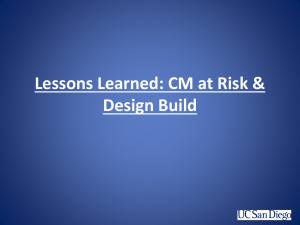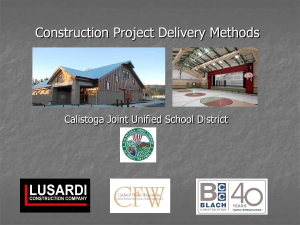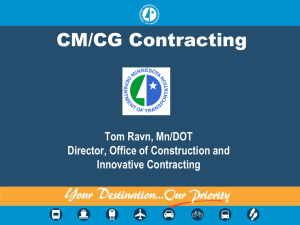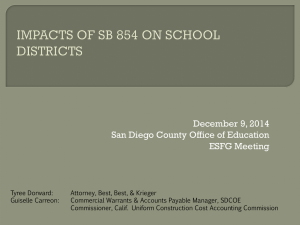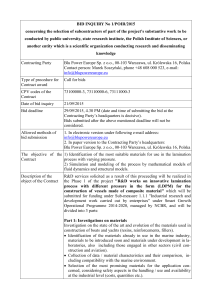Regardless of the Delivery Method
advertisement
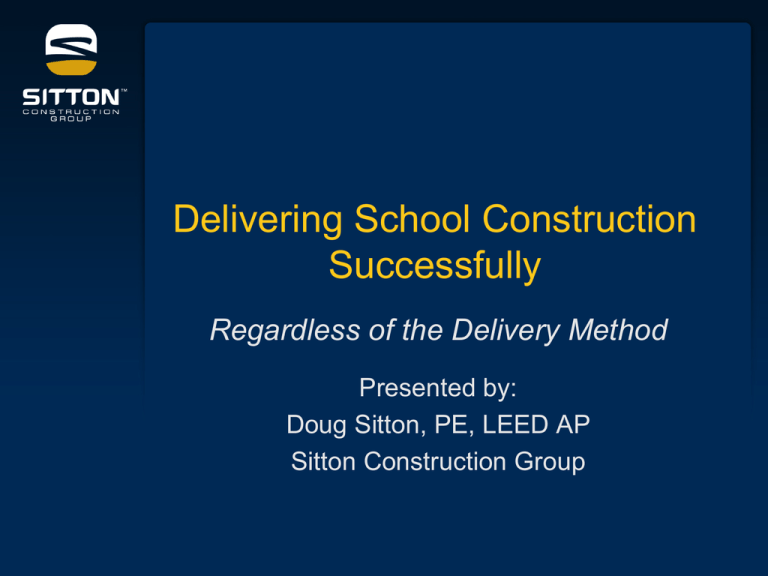
Delivering School Construction Successfully Regardless of the Delivery Method Presented by: Doug Sitton, PE, LEED AP Sitton Construction Group What if you could spend less time, reduce the overall cost, and eliminate most of the problems on your next construction project without reducing quantity or quality? Agenda • • • • • • Case Studies Project Complexity Bridging the Gaps Keys to Success Project Delivery Additional Tips Projects That Fell Short What did the following projects all have in common that caused them to fall short of expectations? Project #1 • • • • • • New High School Design/bid/build with CM as Advisor $45 million new construction 20-month original schedule 12 months late 14% delay claims/change orders Project #2 • • • • • University Student Rec Center CM at Risk $13 million new construction 15-month original schedule 12 months late Project #3 • • • • • University Student Center Design/bid/build – multiple prime $14 million addition/renovation 18-month original schedule 12 months late Project #4 • • • • • • New College Classroom Building Design/bid/build – multiple prime $11 million new construction/addition 21-month original schedule 15 months late 11% delay claims/change orders What Was The Common Cause? What did each of these projects have in common? A. Under-qualified contractor(s) or CM B. Under-qualified architect/engineer C. Wrong delivery method D. Unusually complex E. Other The Common Cause What did each of these projects have in common? The gaps that existed were not filled Gaps are caused by complexity Successful Case Study #1 • • • • • $60 million program 2 new elementary schools Various additions/renovations Design/bid/build – single primes Delivered in 16 months and under budget Successful Case Study #2 • $6 million program • Renovations to elementary and high schools • D/B/B – single primes and PC • Saved $550,000 while adding in quantity and quality Project Complexity Project Organizational Chart Thousands of exchanges of info in different languages • • • • • • • • • • Owner Funding sources Design firms Consultants Contractors Subcontractors Utilities Regulatory agencies Manufacturers/vendors Stakeholders Design/Construction Complexity Organizations X People X Processes X Technical X External Forces Technical Complexity • Systems: – – – – – • • • • Structural MEP/FP Security Data/telecommunications Furnishings and equipment Codes, soils, environmental, etc. Project delivery LEED BIM The Cost of Complexity U. of I. Sues over Dorm's Big Cost Overrun Cost Overruns at Prairie State Energy SCHOOL BOARD TO MEET ON SCHOOL COST OVERRUNS MetroLink Files Damage Suit Against Four Companies Big Dig Cost Explodes To $22 Billion from Original $2.6 Billion Complexity = Change Orders Complexity = Change Orders Gaps Why Complexity Often Wins Where Are The Gaps? Between all project participants • • • • • • • • • • Owner Funding sources Design firms Consultants Contractors Subcontractors Utilities Regulatory agencies Manufacturers/vendors Stakeholders What are the Gaps? • • • • • Knowledge and experience Priorities, goals and objectives Roles, responsibilities and risk Information and communication Cultures and personalities • Performance and results Bridging the Gaps The Owner’s (District’s) Role Build the bridges Start with the 3 legs The Owner is responsible for the team of teams. The Owner’s Role • • • • • • • • • • • Financing/budget/costs Project delivery method Requirements/program/operations/objectives Property/surveys/utilities/environmental/soils Existing conditions/testing Schedule Permits Furniture/Fixtures/Equipment Voice/Data/Security Move management Reviews/decisions The Owner’s Role • Procurement and performance – – – – – Architect/engineer Consultants Contractors Construction manager Performance contractor • Dispute resolution The Owner’s Required Expertise Bridge building: • Improve all contracts • Manage and improve everyone’s performance • Facilitate collaboration and teamwork • Streamline and improve the delivery of planning, design and construction Who Wins When The Owner Has Sufficient Resources? Everyone! Two Options: Win-Win or Lose-Lose Minimize the Owner’s Role? • Avoid paying for expertise? Any expertise should more than pay for itself • Hand it off to the Architect, CM or PC? Time, focus, qualifications, conflicts Design Performance Contractor CM at Risk GC or CM at Risk Design Performance Contractor GC or CM at Risk Design CM CM Design C C C C C C C C C C C C C C C C C C C C C C C C C Keys to Success 10 Pieces to the Successful Project Puzzle 10 Pieces to the Project Puzzle 1. 2. 3. 4. 5. 6. 7. 8. 9. 10. Identify Owner’s Expertise Establish Goals and Objectives Maximize Competition for Selection Negotiate Effective Contracts Place Right People in Right Roles Plan Ahead Establish Effective Processes Set Performance Metrics Apply Cost-Effective Technology Lead and Manage Proactively Solve It at the Beginning . Project Delivery Methods and Myths Project Delivery Methods • Design/Bid/Build – Single Prime • Design/Bid/Build – Multiple Prime or CM • Construction Manager at Risk • Performance Contracting Owner Owner GC or CM at Risk Design Performance Contractor Owner CM Design C C C C C C C C C C C C C C C C C C C C C C C C C Design/Bid/Build – Single Prime • Owner contracts with a design team • Design team provides design and produces bid/construction documents • Project is bid to single general contractor • Low responsive, responsible bidder selected Owner Design General Contractor Design/Bid/Build – Multiple Prime Same as Single Prime except: • Project is bid in multiple packages • Low responsive, responsible bidders selected • Multiple primes “assigned” to general contractor as coordinating contractor Owner GC as Coordinating Contractor Design C C C C C General Contractor as CMa Same as Multiple Prime except: • Owner contracts with a CM • CM participates in design phase • Owner is at risk and holds all contracts – no “assignments” • Typically many more contracts Owner GC as CMa Design C C C C C C C C C C C C C C C C C C C C C C C C C General Contractor as CM at Risk Same as GC as CMa except: • GC holds the contracts and is at risk Owner Design GC as CM at Risk Performance Contracting • Same as Design-Build except: • For energy savings improvements • ESCO provides: – Financing – Guaranteed energy savings Owner Performance Contractor Which Method . . . Can be completed in the least amount of time? Requires the least amount of District time to oversee? Takes the least amount of District expertise to manage? Has the fewest change orders? Involves the least risk for the District? Provides the highest overall value for the District? Design/Bid/Build – single prime Design/Bid/Build – multiple prime or CMa Construction Manager at Risk Performance Contracting It depends Which Method . . . Can be completed in the least amount of time? Requires the least amount of District time to oversee? Takes the least amount of District expertise to manage? Has the fewest change orders? Involves the least risk for the District? Provides the highest overall value for the District? Design/Bid/Build – single prime Design/Bid/Build – multiple prime or CMa Construction Manager at Risk Performance Contracting It depends It Depends • Every method: – Has positives and negatives, has succeeded and failed – Is complex, just in a different way – Can be fast-tracked – Should never be used “as is” – Should be tailored to the specific client, project, and local/current market • Customization and management matter most, not the method Selecting Project Delivery Consider: • Most common, best understood • Experience and knowledge of: architect, engineers, contractors Don’t consider: • Time – overall or District’s • Change orders • Risk These are customization considerations Additional Tips for Success Minimizing Owner’s Time Invested • Have the right level of expertise • Invest the time early • Avoid gaps More time here Pick Any Two • The Project Management Triangle • Why not have all three? • • • • Low quality often adds cost and time Quality design can reduce overall cost “Too” slow and “too” fast both cost more Effective Owner management improves all three Improving All Three – Q/B/S “Avoidable failures are common and persistent . . . the volume and complexity of what we know has exceeded our individual ability to deliver its benefits correctly, safely, or reliably.” “We need a new strategy . . . and there is such a strategy. It is a checklist.” Getting Things Right • Ninety-second checklist • Complex world of surgery • Eight hospitals around the world • All kinds of operations • Reduced deaths and complications by one-third • No cost Example Checklists • • • • • Facility appraisals Facility assessments Plan/spec reviews Inter-disciplinary reviews Scorecards eTools Examples • Building Information Modeling (BIM) • eProject Management • eDeliverables Summarizing Success • Understand the complexity • Identify expertise necessary for the District’s “Owner” role • Identify/predict the gaps • Bridge the gaps • Use checklists! Equal Understanding is Key “Armed with the most the most powerful weapon in anyone’s business arsenal – understanding – you will have a fighting chance to get the building you want, when you want it, for the price you originally agreed upon.” Broken Buildings, Busted Budgets by Barry LePatner
